Stakeholder Engagement in Change Processes
VerifiedAdded on 2022/05/25
|12
|3382
|145
AI Summary
Change management is the method of implementing a prepared and structured business strategy to better align the company with change. In its simplest and most successful form, change management includes engaging with the stakeholder groups to the company to help them understand what change means to them to help them make and support the transition and to work to address any obstacles involved. Learn how effective stakeholder involvement is crucial to the success of any company.
Contribute Materials
Your contribution can guide someone’s learning journey. Share your
documents today.
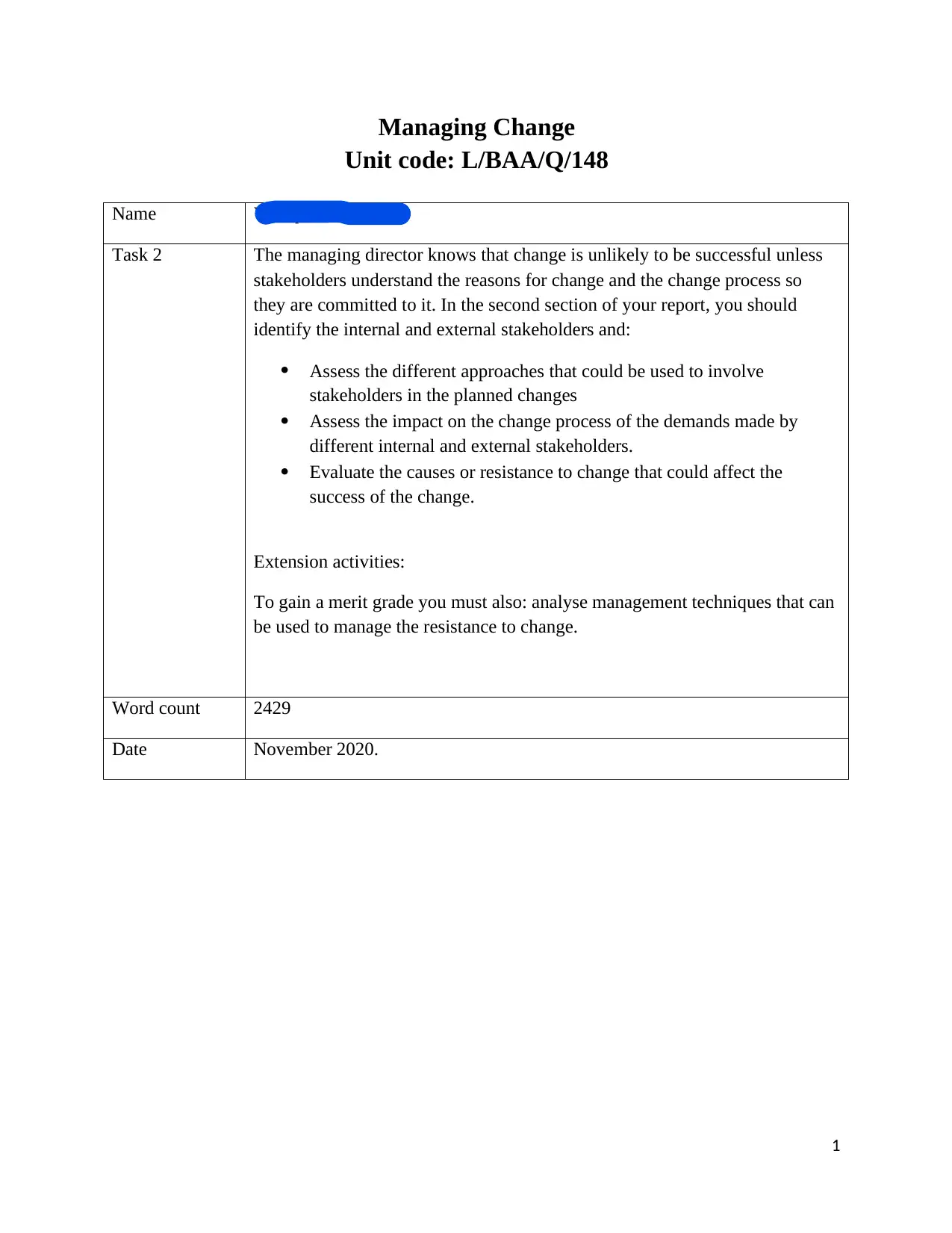
1
Managing Change
Unit code: L/BAA/Q/148
Name Yanique Townsend
Task 2 The managing director knows that change is unlikely to be successful unless
stakeholders understand the reasons for change and the change process so
they are committed to it. In the second section of your report, you should
identify the internal and external stakeholders and:
Assess the different approaches that could be used to involve
stakeholders in the planned changes
Assess the impact on the change process of the demands made by
different internal and external stakeholders.
Evaluate the causes or resistance to change that could affect the
success of the change.
Extension activities:
To gain a merit grade you must also: analyse management techniques that can
be used to manage the resistance to change.
Word count 2429
Date November 2020.
Managing Change
Unit code: L/BAA/Q/148
Name Yanique Townsend
Task 2 The managing director knows that change is unlikely to be successful unless
stakeholders understand the reasons for change and the change process so
they are committed to it. In the second section of your report, you should
identify the internal and external stakeholders and:
Assess the different approaches that could be used to involve
stakeholders in the planned changes
Assess the impact on the change process of the demands made by
different internal and external stakeholders.
Evaluate the causes or resistance to change that could affect the
success of the change.
Extension activities:
To gain a merit grade you must also: analyse management techniques that can
be used to manage the resistance to change.
Word count 2429
Date November 2020.
Secure Best Marks with AI Grader
Need help grading? Try our AI Grader for instant feedback on your assignments.
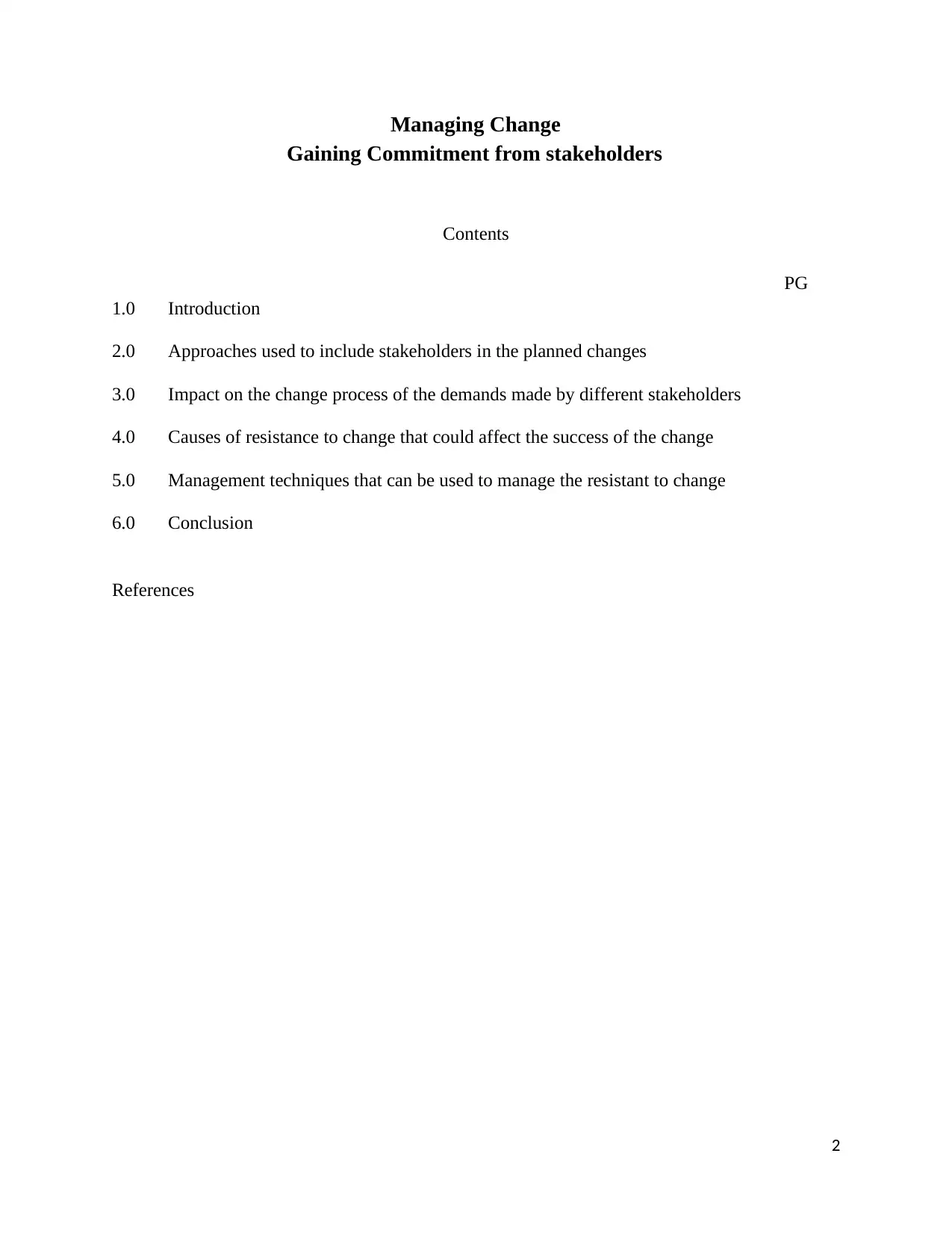
2
Managing Change
Gaining Commitment from stakeholders
Contents
PG
1.0 Introduction
2.0 Approaches used to include stakeholders in the planned changes
3.0 Impact on the change process of the demands made by different stakeholders
4.0 Causes of resistance to change that could affect the success of the change
5.0 Management techniques that can be used to manage the resistant to change
6.0 Conclusion
References
Managing Change
Gaining Commitment from stakeholders
Contents
PG
1.0 Introduction
2.0 Approaches used to include stakeholders in the planned changes
3.0 Impact on the change process of the demands made by different stakeholders
4.0 Causes of resistance to change that could affect the success of the change
5.0 Management techniques that can be used to manage the resistant to change
6.0 Conclusion
References
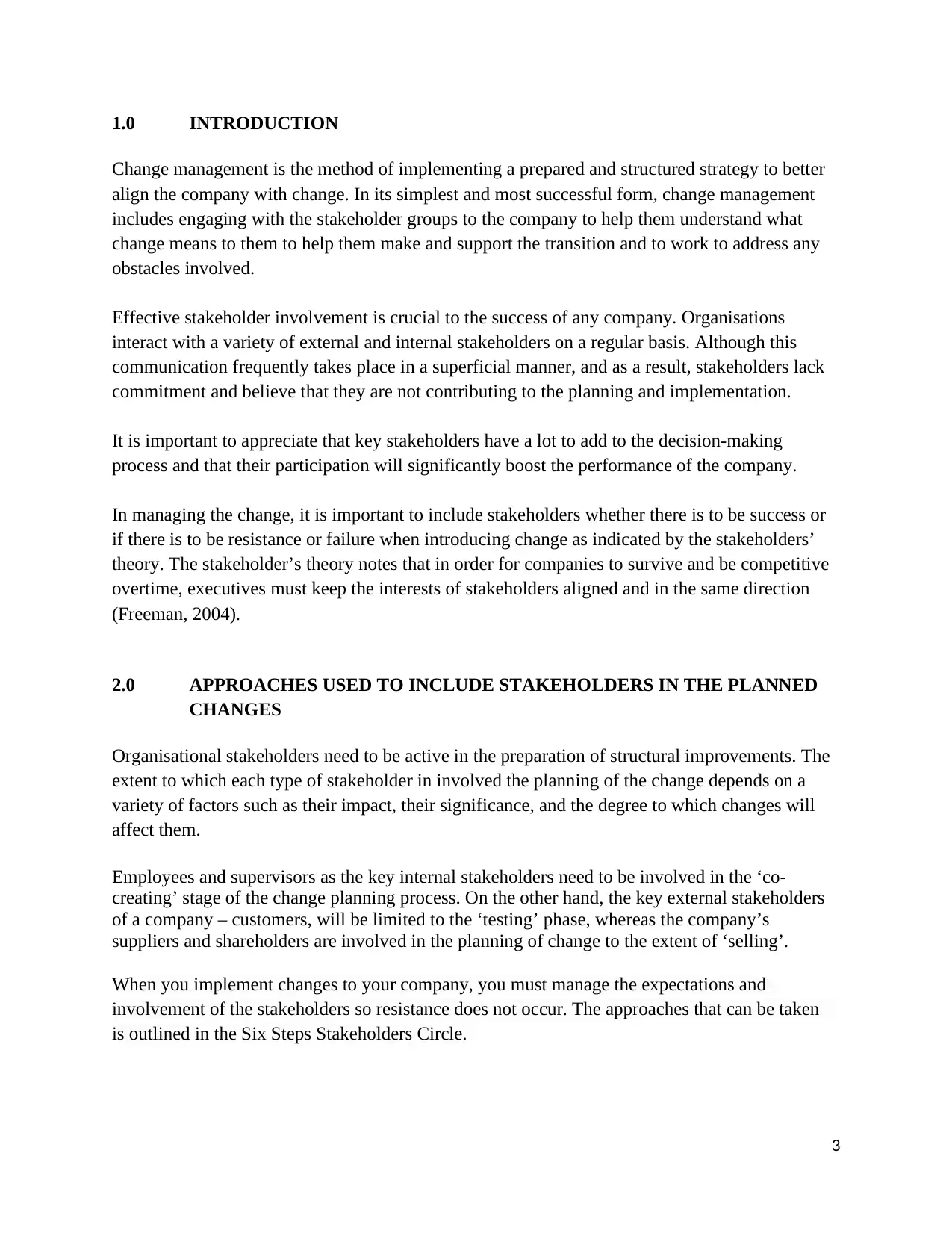
3
1.0 INTRODUCTION
Change management is the method of implementing a prepared and structured strategy to better
align the company with change. In its simplest and most successful form, change management
includes engaging with the stakeholder groups to the company to help them understand what
change means to them to help them make and support the transition and to work to address any
obstacles involved.
Effective stakeholder involvement is crucial to the success of any company. Organisations
interact with a variety of external and internal stakeholders on a regular basis. Although this
communication frequently takes place in a superficial manner, and as a result, stakeholders lack
commitment and believe that they are not contributing to the planning and implementation.
It is important to appreciate that key stakeholders have a lot to add to the decision-making
process and that their participation will significantly boost the performance of the company.
In managing the change, it is important to include stakeholders whether there is to be success or
if there is to be resistance or failure when introducing change as indicated by the stakeholders’
theory. The stakeholder’s theory notes that in order for companies to survive and be competitive
overtime, executives must keep the interests of stakeholders aligned and in the same direction
(Freeman, 2004).
2.0 APPROACHES USED TO INCLUDE STAKEHOLDERS IN THE PLANNED
CHANGES
Organisational stakeholders need to be active in the preparation of structural improvements. The
extent to which each type of stakeholder in involved the planning of the change depends on a
variety of factors such as their impact, their significance, and the degree to which changes will
affect them.
Employees and supervisors as the key internal stakeholders need to be involved in the ‘co-
creating’ stage of the change planning process. On the other hand, the key external stakeholders
of a company – customers, will be limited to the ‘testing’ phase, whereas the company’s
suppliers and shareholders are involved in the planning of change to the extent of ‘selling’.
When you implement changes to your company, you must manage the expectations and
involvement of the stakeholders so resistance does not occur. The approaches that can be taken
is outlined in the Six Steps Stakeholders Circle.
1.0 INTRODUCTION
Change management is the method of implementing a prepared and structured strategy to better
align the company with change. In its simplest and most successful form, change management
includes engaging with the stakeholder groups to the company to help them understand what
change means to them to help them make and support the transition and to work to address any
obstacles involved.
Effective stakeholder involvement is crucial to the success of any company. Organisations
interact with a variety of external and internal stakeholders on a regular basis. Although this
communication frequently takes place in a superficial manner, and as a result, stakeholders lack
commitment and believe that they are not contributing to the planning and implementation.
It is important to appreciate that key stakeholders have a lot to add to the decision-making
process and that their participation will significantly boost the performance of the company.
In managing the change, it is important to include stakeholders whether there is to be success or
if there is to be resistance or failure when introducing change as indicated by the stakeholders’
theory. The stakeholder’s theory notes that in order for companies to survive and be competitive
overtime, executives must keep the interests of stakeholders aligned and in the same direction
(Freeman, 2004).
2.0 APPROACHES USED TO INCLUDE STAKEHOLDERS IN THE PLANNED
CHANGES
Organisational stakeholders need to be active in the preparation of structural improvements. The
extent to which each type of stakeholder in involved the planning of the change depends on a
variety of factors such as their impact, their significance, and the degree to which changes will
affect them.
Employees and supervisors as the key internal stakeholders need to be involved in the ‘co-
creating’ stage of the change planning process. On the other hand, the key external stakeholders
of a company – customers, will be limited to the ‘testing’ phase, whereas the company’s
suppliers and shareholders are involved in the planning of change to the extent of ‘selling’.
When you implement changes to your company, you must manage the expectations and
involvement of the stakeholders so resistance does not occur. The approaches that can be taken
is outlined in the Six Steps Stakeholders Circle.
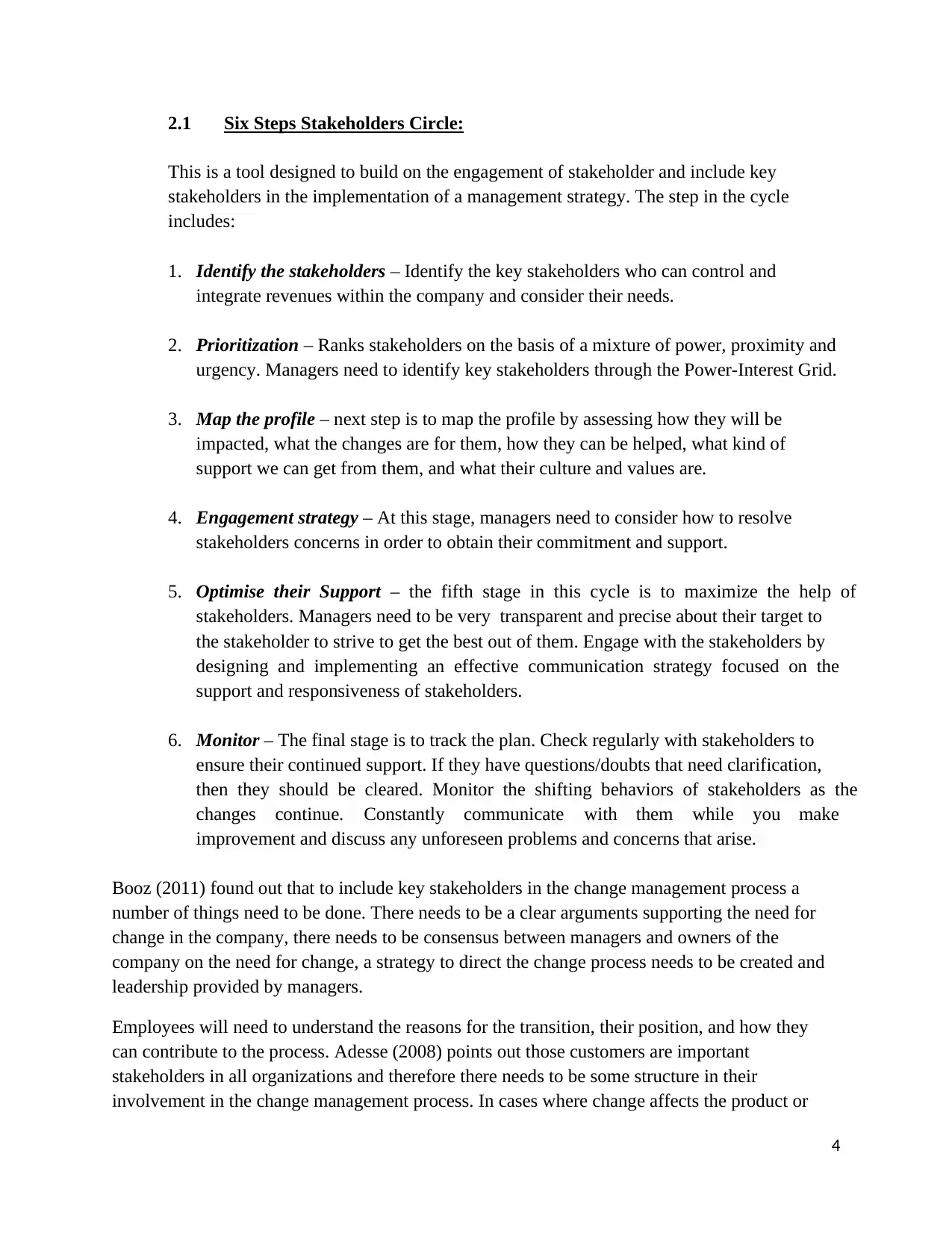
4
2.1 Six Steps Stakeholders Circle:
This is a tool designed to build on the engagement of stakeholder and include key
stakeholders in the implementation of a management strategy. The step in the cycle
includes:
1. Identify the stakeholders – Identify the key stakeholders who can control and
integrate revenues within the company and consider their needs.
2. Prioritization – Ranks stakeholders on the basis of a mixture of power, proximity and
urgency. Managers need to identify key stakeholders through the Power-Interest Grid.
3. Map the profile – next step is to map the profile by assessing how they will be
impacted, what the changes are for them, how they can be helped, what kind of
support we can get from them, and what their culture and values are.
4. Engagement strategy – At this stage, managers need to consider how to resolve
stakeholders concerns in order to obtain their commitment and support.
5. Optimise their Support – the fifth stage in this cycle is to maximize the help of
stakeholders. Managers need to be very transparent and precise about their target to
the stakeholder to strive to get the best out of them. Engage with the stakeholders by
designing and implementing an effective communication strategy focused on the
support and responsiveness of stakeholders.
6. Monitor – The final stage is to track the plan. Check regularly with stakeholders to
ensure their continued support. If they have questions/doubts that need clarification,
then they should be cleared. Monitor the shifting behaviors of stakeholders as the
changes continue. Constantly communicate with them while you make
improvement and discuss any unforeseen problems and concerns that arise.
Booz (2011) found out that to include key stakeholders in the change management process a
number of things need to be done. There needs to be a clear arguments supporting the need for
change in the company, there needs to be consensus between managers and owners of the
company on the need for change, a strategy to direct the change process needs to be created and
leadership provided by managers.
Employees will need to understand the reasons for the transition, their position, and how they
can contribute to the process. Adesse (2008) points out those customers are important
stakeholders in all organizations and therefore there needs to be some structure in their
involvement in the change management process. In cases where change affects the product or
2.1 Six Steps Stakeholders Circle:
This is a tool designed to build on the engagement of stakeholder and include key
stakeholders in the implementation of a management strategy. The step in the cycle
includes:
1. Identify the stakeholders – Identify the key stakeholders who can control and
integrate revenues within the company and consider their needs.
2. Prioritization – Ranks stakeholders on the basis of a mixture of power, proximity and
urgency. Managers need to identify key stakeholders through the Power-Interest Grid.
3. Map the profile – next step is to map the profile by assessing how they will be
impacted, what the changes are for them, how they can be helped, what kind of
support we can get from them, and what their culture and values are.
4. Engagement strategy – At this stage, managers need to consider how to resolve
stakeholders concerns in order to obtain their commitment and support.
5. Optimise their Support – the fifth stage in this cycle is to maximize the help of
stakeholders. Managers need to be very transparent and precise about their target to
the stakeholder to strive to get the best out of them. Engage with the stakeholders by
designing and implementing an effective communication strategy focused on the
support and responsiveness of stakeholders.
6. Monitor – The final stage is to track the plan. Check regularly with stakeholders to
ensure their continued support. If they have questions/doubts that need clarification,
then they should be cleared. Monitor the shifting behaviors of stakeholders as the
changes continue. Constantly communicate with them while you make
improvement and discuss any unforeseen problems and concerns that arise.
Booz (2011) found out that to include key stakeholders in the change management process a
number of things need to be done. There needs to be a clear arguments supporting the need for
change in the company, there needs to be consensus between managers and owners of the
company on the need for change, a strategy to direct the change process needs to be created and
leadership provided by managers.
Employees will need to understand the reasons for the transition, their position, and how they
can contribute to the process. Adesse (2008) points out those customers are important
stakeholders in all organizations and therefore there needs to be some structure in their
involvement in the change management process. In cases where change affects the product or
Secure Best Marks with AI Grader
Need help grading? Try our AI Grader for instant feedback on your assignments.
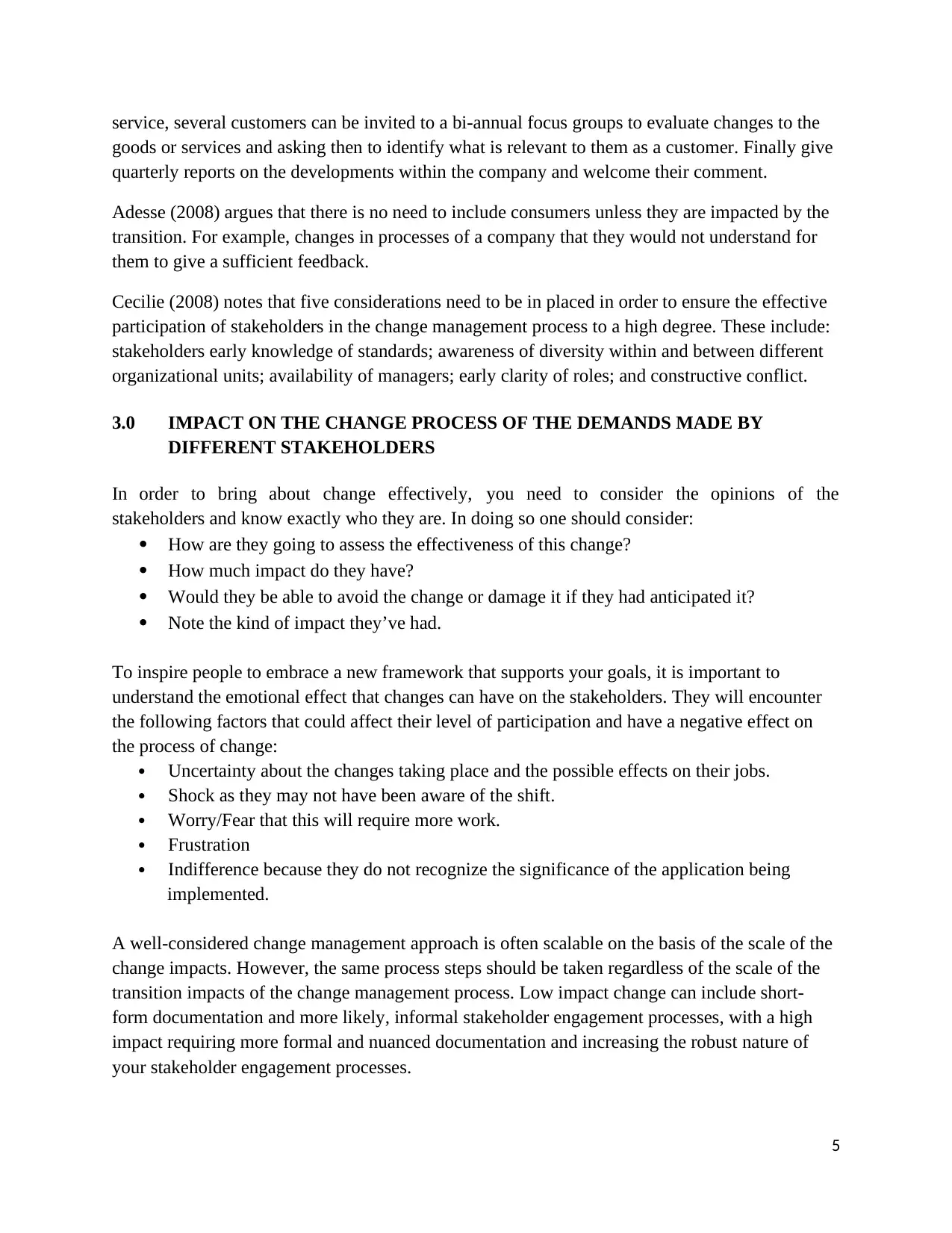
5
service, several customers can be invited to a bi-annual focus groups to evaluate changes to the
goods or services and asking then to identify what is relevant to them as a customer. Finally give
quarterly reports on the developments within the company and welcome their comment.
Adesse (2008) argues that there is no need to include consumers unless they are impacted by the
transition. For example, changes in processes of a company that they would not understand for
them to give a sufficient feedback.
Cecilie (2008) notes that five considerations need to be in placed in order to ensure the effective
participation of stakeholders in the change management process to a high degree. These include:
stakeholders early knowledge of standards; awareness of diversity within and between different
organizational units; availability of managers; early clarity of roles; and constructive conflict.
3.0 IMPACT ON THE CHANGE PROCESS OF THE DEMANDS MADE BY
DIFFERENT STAKEHOLDERS
In order to bring about change effectively, you need to consider the opinions of the
stakeholders and know exactly who they are. In doing so one should consider:
How are they going to assess the effectiveness of this change?
How much impact do they have?
Would they be able to avoid the change or damage it if they had anticipated it?
Note the kind of impact they’ve had.
To inspire people to embrace a new framework that supports your goals, it is important to
understand the emotional effect that changes can have on the stakeholders. They will encounter
the following factors that could affect their level of participation and have a negative effect on
the process of change:
Uncertainty about the changes taking place and the possible effects on their jobs.
Shock as they may not have been aware of the shift.
Worry/Fear that this will require more work.
Frustration
Indifference because they do not recognize the significance of the application being
implemented.
A well-considered change management approach is often scalable on the basis of the scale of the
change impacts. However, the same process steps should be taken regardless of the scale of the
transition impacts of the change management process. Low impact change can include short-
form documentation and more likely, informal stakeholder engagement processes, with a high
impact requiring more formal and nuanced documentation and increasing the robust nature of
your stakeholder engagement processes.
service, several customers can be invited to a bi-annual focus groups to evaluate changes to the
goods or services and asking then to identify what is relevant to them as a customer. Finally give
quarterly reports on the developments within the company and welcome their comment.
Adesse (2008) argues that there is no need to include consumers unless they are impacted by the
transition. For example, changes in processes of a company that they would not understand for
them to give a sufficient feedback.
Cecilie (2008) notes that five considerations need to be in placed in order to ensure the effective
participation of stakeholders in the change management process to a high degree. These include:
stakeholders early knowledge of standards; awareness of diversity within and between different
organizational units; availability of managers; early clarity of roles; and constructive conflict.
3.0 IMPACT ON THE CHANGE PROCESS OF THE DEMANDS MADE BY
DIFFERENT STAKEHOLDERS
In order to bring about change effectively, you need to consider the opinions of the
stakeholders and know exactly who they are. In doing so one should consider:
How are they going to assess the effectiveness of this change?
How much impact do they have?
Would they be able to avoid the change or damage it if they had anticipated it?
Note the kind of impact they’ve had.
To inspire people to embrace a new framework that supports your goals, it is important to
understand the emotional effect that changes can have on the stakeholders. They will encounter
the following factors that could affect their level of participation and have a negative effect on
the process of change:
Uncertainty about the changes taking place and the possible effects on their jobs.
Shock as they may not have been aware of the shift.
Worry/Fear that this will require more work.
Frustration
Indifference because they do not recognize the significance of the application being
implemented.
A well-considered change management approach is often scalable on the basis of the scale of the
change impacts. However, the same process steps should be taken regardless of the scale of the
transition impacts of the change management process. Low impact change can include short-
form documentation and more likely, informal stakeholder engagement processes, with a high
impact requiring more formal and nuanced documentation and increasing the robust nature of
your stakeholder engagement processes.
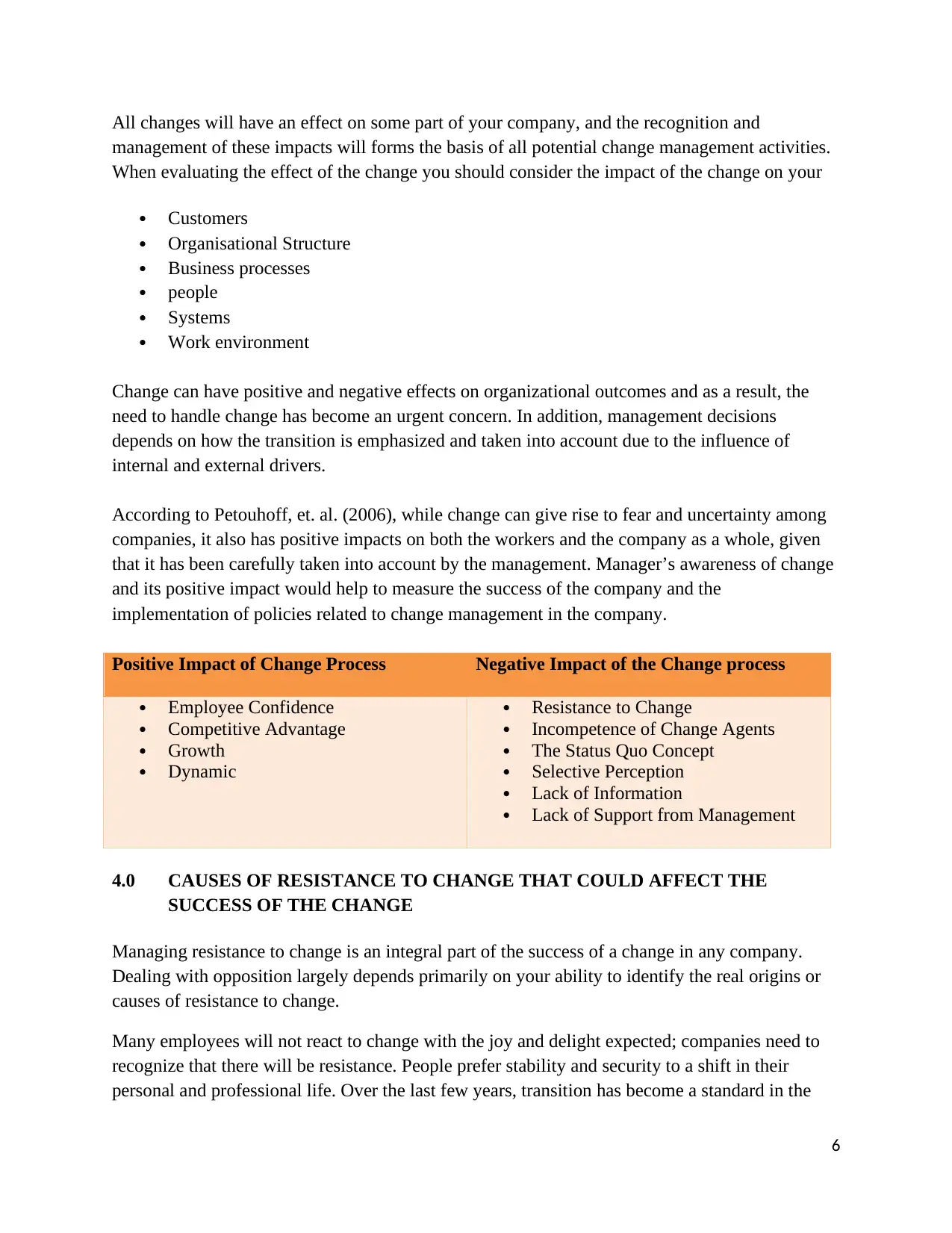
6
All changes will have an effect on some part of your company, and the recognition and
management of these impacts will forms the basis of all potential change management activities.
When evaluating the effect of the change you should consider the impact of the change on your
Customers
Organisational Structure
Business processes
people
Systems
Work environment
Change can have positive and negative effects on organizational outcomes and as a result, the
need to handle change has become an urgent concern. In addition, management decisions
depends on how the transition is emphasized and taken into account due to the influence of
internal and external drivers.
According to Petouhoff, et. al. (2006), while change can give rise to fear and uncertainty among
companies, it also has positive impacts on both the workers and the company as a whole, given
that it has been carefully taken into account by the management. Manager’s awareness of change
and its positive impact would help to measure the success of the company and the
implementation of policies related to change management in the company.
Positive Impact of Change Process Negative Impact of the Change process
Employee Confidence
Competitive Advantage
Growth
Dynamic
Resistance to Change
Incompetence of Change Agents
The Status Quo Concept
Selective Perception
Lack of Information
Lack of Support from Management
4.0 CAUSES OF RESISTANCE TO CHANGE THAT COULD AFFECT THE
SUCCESS OF THE CHANGE
Managing resistance to change is an integral part of the success of a change in any company.
Dealing with opposition largely depends primarily on your ability to identify the real origins or
causes of resistance to change.
Many employees will not react to change with the joy and delight expected; companies need to
recognize that there will be resistance. People prefer stability and security to a shift in their
personal and professional life. Over the last few years, transition has become a standard in the
All changes will have an effect on some part of your company, and the recognition and
management of these impacts will forms the basis of all potential change management activities.
When evaluating the effect of the change you should consider the impact of the change on your
Customers
Organisational Structure
Business processes
people
Systems
Work environment
Change can have positive and negative effects on organizational outcomes and as a result, the
need to handle change has become an urgent concern. In addition, management decisions
depends on how the transition is emphasized and taken into account due to the influence of
internal and external drivers.
According to Petouhoff, et. al. (2006), while change can give rise to fear and uncertainty among
companies, it also has positive impacts on both the workers and the company as a whole, given
that it has been carefully taken into account by the management. Manager’s awareness of change
and its positive impact would help to measure the success of the company and the
implementation of policies related to change management in the company.
Positive Impact of Change Process Negative Impact of the Change process
Employee Confidence
Competitive Advantage
Growth
Dynamic
Resistance to Change
Incompetence of Change Agents
The Status Quo Concept
Selective Perception
Lack of Information
Lack of Support from Management
4.0 CAUSES OF RESISTANCE TO CHANGE THAT COULD AFFECT THE
SUCCESS OF THE CHANGE
Managing resistance to change is an integral part of the success of a change in any company.
Dealing with opposition largely depends primarily on your ability to identify the real origins or
causes of resistance to change.
Many employees will not react to change with the joy and delight expected; companies need to
recognize that there will be resistance. People prefer stability and security to a shift in their
personal and professional life. Over the last few years, transition has become a standard in the
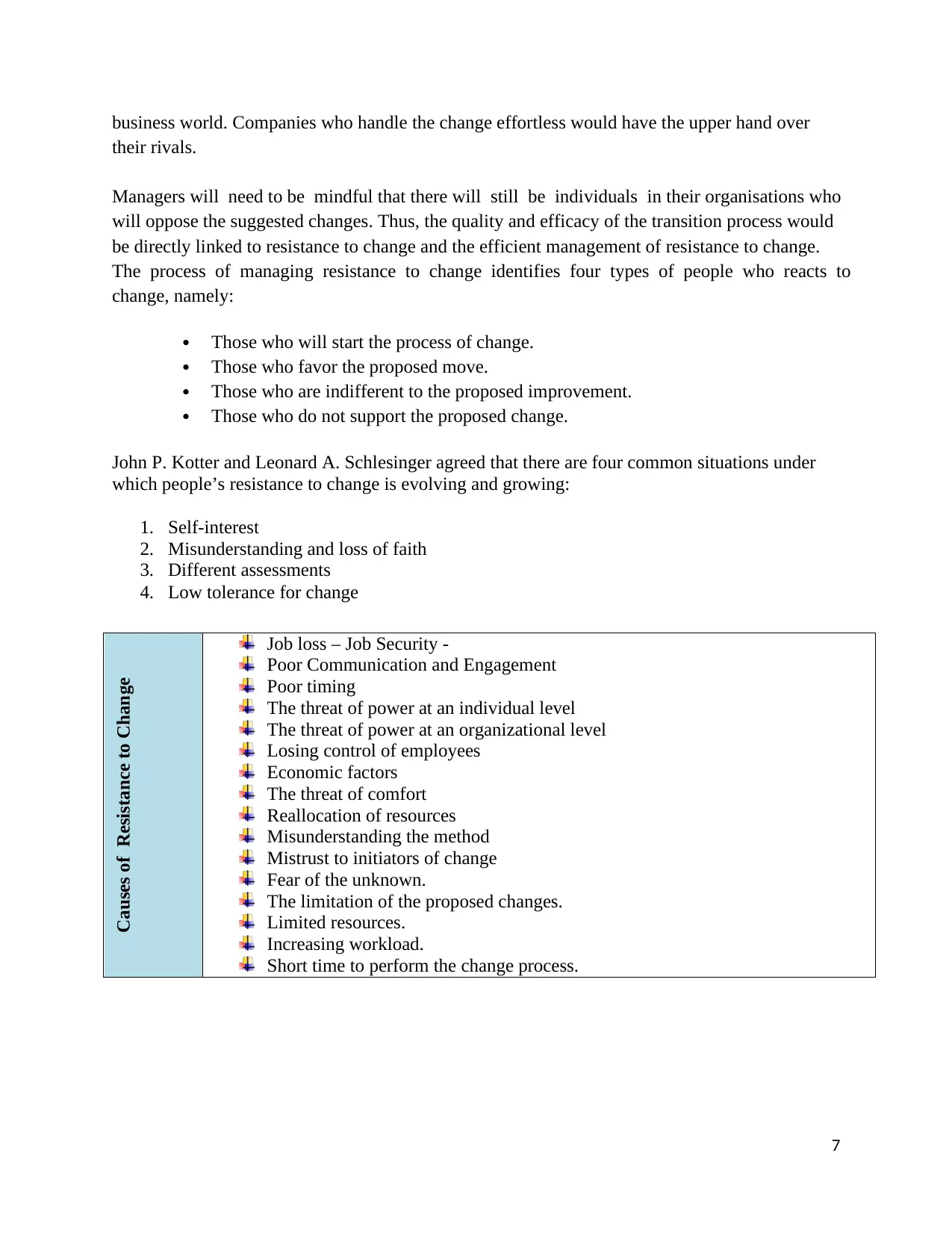
7
business world. Companies who handle the change effortless would have the upper hand over
their rivals.
Managers will need to be mindful that there will still be individuals in their organisations who
will oppose the suggested changes. Thus, the quality and efficacy of the transition process would
be directly linked to resistance to change and the efficient management of resistance to change.
The process of managing resistance to change identifies four types of people who reacts to
change, namely:
Those who will start the process of change.
Those who favor the proposed move.
Those who are indifferent to the proposed improvement.
Those who do not support the proposed change.
John P. Kotter and Leonard A. Schlesinger agreed that there are four common situations under
which people’s resistance to change is evolving and growing:
1. Self-interest
2. Misunderstanding and loss of faith
3. Different assessments
4. Low tolerance for change
Causes of Resistance to Change
Job loss – Job Security -
Poor Communication and Engagement
Poor timing
The threat of power at an individual level
The threat of power at an organizational level
Losing control of employees
Economic factors
The threat of comfort
Reallocation of resources
Misunderstanding the method
Mistrust to initiators of change
Fear of the unknown.
The limitation of the proposed changes.
Limited resources.
Increasing workload.
Short time to perform the change process.
business world. Companies who handle the change effortless would have the upper hand over
their rivals.
Managers will need to be mindful that there will still be individuals in their organisations who
will oppose the suggested changes. Thus, the quality and efficacy of the transition process would
be directly linked to resistance to change and the efficient management of resistance to change.
The process of managing resistance to change identifies four types of people who reacts to
change, namely:
Those who will start the process of change.
Those who favor the proposed move.
Those who are indifferent to the proposed improvement.
Those who do not support the proposed change.
John P. Kotter and Leonard A. Schlesinger agreed that there are four common situations under
which people’s resistance to change is evolving and growing:
1. Self-interest
2. Misunderstanding and loss of faith
3. Different assessments
4. Low tolerance for change
Causes of Resistance to Change
Job loss – Job Security -
Poor Communication and Engagement
Poor timing
The threat of power at an individual level
The threat of power at an organizational level
Losing control of employees
Economic factors
The threat of comfort
Reallocation of resources
Misunderstanding the method
Mistrust to initiators of change
Fear of the unknown.
The limitation of the proposed changes.
Limited resources.
Increasing workload.
Short time to perform the change process.
Paraphrase This Document
Need a fresh take? Get an instant paraphrase of this document with our AI Paraphraser
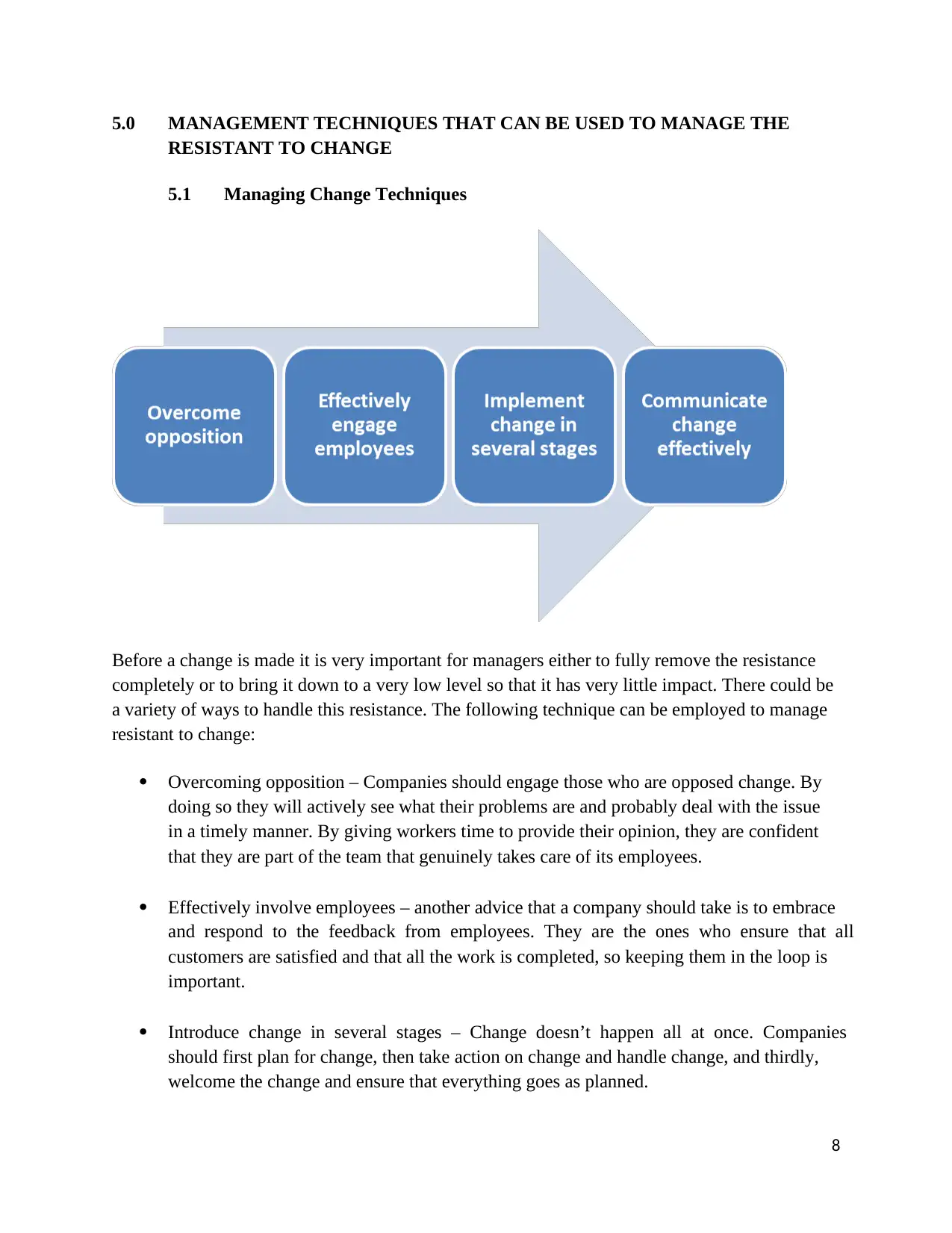
8
5.0 MANAGEMENT TECHNIQUES THAT CAN BE USED TO MANAGE THE
RESISTANT TO CHANGE
5.1 Managing Change Techniques
Before a change is made it is very important for managers either to fully remove the resistance
completely or to bring it down to a very low level so that it has very little impact. There could be
a variety of ways to handle this resistance. The following technique can be employed to manage
resistant to change:
Overcoming opposition – Companies should engage those who are opposed change. By
doing so they will actively see what their problems are and probably deal with the issue
in a timely manner. By giving workers time to provide their opinion, they are confident
that they are part of the team that genuinely takes care of its employees.
Effectively involve employees – another advice that a company should take is to embrace
and respond to the feedback from employees. They are the ones who ensure that all
customers are satisfied and that all the work is completed, so keeping them in the loop is
important.
Introduce change in several stages – Change doesn’t happen all at once. Companies
should first plan for change, then take action on change and handle change, and thirdly,
welcome the change and ensure that everything goes as planned.
5.0 MANAGEMENT TECHNIQUES THAT CAN BE USED TO MANAGE THE
RESISTANT TO CHANGE
5.1 Managing Change Techniques
Before a change is made it is very important for managers either to fully remove the resistance
completely or to bring it down to a very low level so that it has very little impact. There could be
a variety of ways to handle this resistance. The following technique can be employed to manage
resistant to change:
Overcoming opposition – Companies should engage those who are opposed change. By
doing so they will actively see what their problems are and probably deal with the issue
in a timely manner. By giving workers time to provide their opinion, they are confident
that they are part of the team that genuinely takes care of its employees.
Effectively involve employees – another advice that a company should take is to embrace
and respond to the feedback from employees. They are the ones who ensure that all
customers are satisfied and that all the work is completed, so keeping them in the loop is
important.
Introduce change in several stages – Change doesn’t happen all at once. Companies
should first plan for change, then take action on change and handle change, and thirdly,
welcome the change and ensure that everything goes as planned.
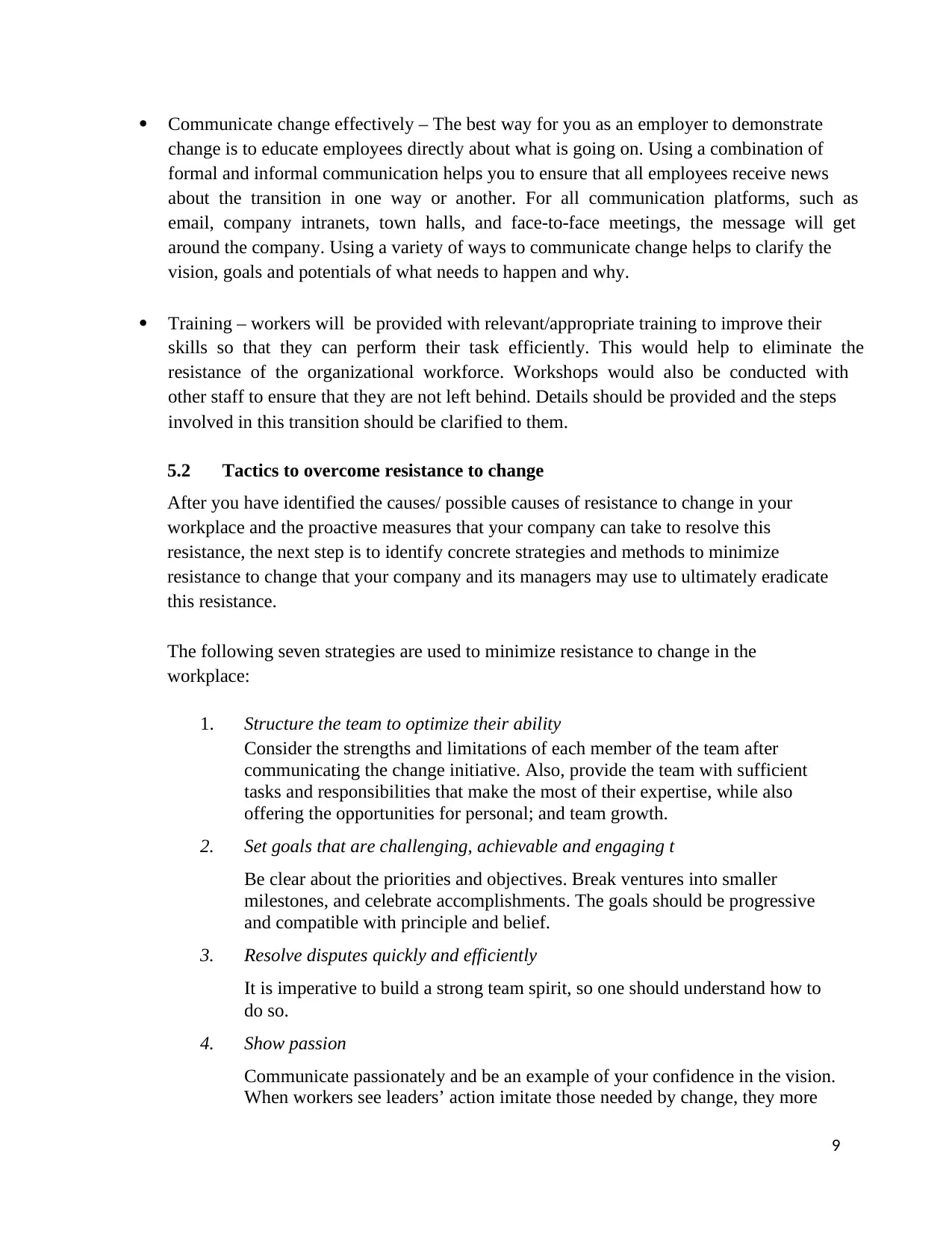
9
Communicate change effectively – The best way for you as an employer to demonstrate
change is to educate employees directly about what is going on. Using a combination of
formal and informal communication helps you to ensure that all employees receive news
about the transition in one way or another. For all communication platforms, such as
email, company intranets, town halls, and face-to-face meetings, the message will get
around the company. Using a variety of ways to communicate change helps to clarify the
vision, goals and potentials of what needs to happen and why.
Training – workers will be provided with relevant/appropriate training to improve their
skills so that they can perform their task efficiently. This would help to eliminate the
resistance of the organizational workforce. Workshops would also be conducted with
other staff to ensure that they are not left behind. Details should be provided and the steps
involved in this transition should be clarified to them.
5.2 Tactics to overcome resistance to change
After you have identified the causes/ possible causes of resistance to change in your
workplace and the proactive measures that your company can take to resolve this
resistance, the next step is to identify concrete strategies and methods to minimize
resistance to change that your company and its managers may use to ultimately eradicate
this resistance.
The following seven strategies are used to minimize resistance to change in the
workplace:
1. Structure the team to optimize their ability
Consider the strengths and limitations of each member of the team after
communicating the change initiative. Also, provide the team with sufficient
tasks and responsibilities that make the most of their expertise, while also
offering the opportunities for personal; and team growth.
2. Set goals that are challenging, achievable and engaging t
Be clear about the priorities and objectives. Break ventures into smaller
milestones, and celebrate accomplishments. The goals should be progressive
and compatible with principle and belief.
3. Resolve disputes quickly and efficiently
It is imperative to build a strong team spirit, so one should understand how to
do so.
4. Show passion
Communicate passionately and be an example of your confidence in the vision.
When workers see leaders’ action imitate those needed by change, they more
Communicate change effectively – The best way for you as an employer to demonstrate
change is to educate employees directly about what is going on. Using a combination of
formal and informal communication helps you to ensure that all employees receive news
about the transition in one way or another. For all communication platforms, such as
email, company intranets, town halls, and face-to-face meetings, the message will get
around the company. Using a variety of ways to communicate change helps to clarify the
vision, goals and potentials of what needs to happen and why.
Training – workers will be provided with relevant/appropriate training to improve their
skills so that they can perform their task efficiently. This would help to eliminate the
resistance of the organizational workforce. Workshops would also be conducted with
other staff to ensure that they are not left behind. Details should be provided and the steps
involved in this transition should be clarified to them.
5.2 Tactics to overcome resistance to change
After you have identified the causes/ possible causes of resistance to change in your
workplace and the proactive measures that your company can take to resolve this
resistance, the next step is to identify concrete strategies and methods to minimize
resistance to change that your company and its managers may use to ultimately eradicate
this resistance.
The following seven strategies are used to minimize resistance to change in the
workplace:
1. Structure the team to optimize their ability
Consider the strengths and limitations of each member of the team after
communicating the change initiative. Also, provide the team with sufficient
tasks and responsibilities that make the most of their expertise, while also
offering the opportunities for personal; and team growth.
2. Set goals that are challenging, achievable and engaging t
Be clear about the priorities and objectives. Break ventures into smaller
milestones, and celebrate accomplishments. The goals should be progressive
and compatible with principle and belief.
3. Resolve disputes quickly and efficiently
It is imperative to build a strong team spirit, so one should understand how to
do so.
4. Show passion
Communicate passionately and be an example of your confidence in the vision.
When workers see leaders’ action imitate those needed by change, they more
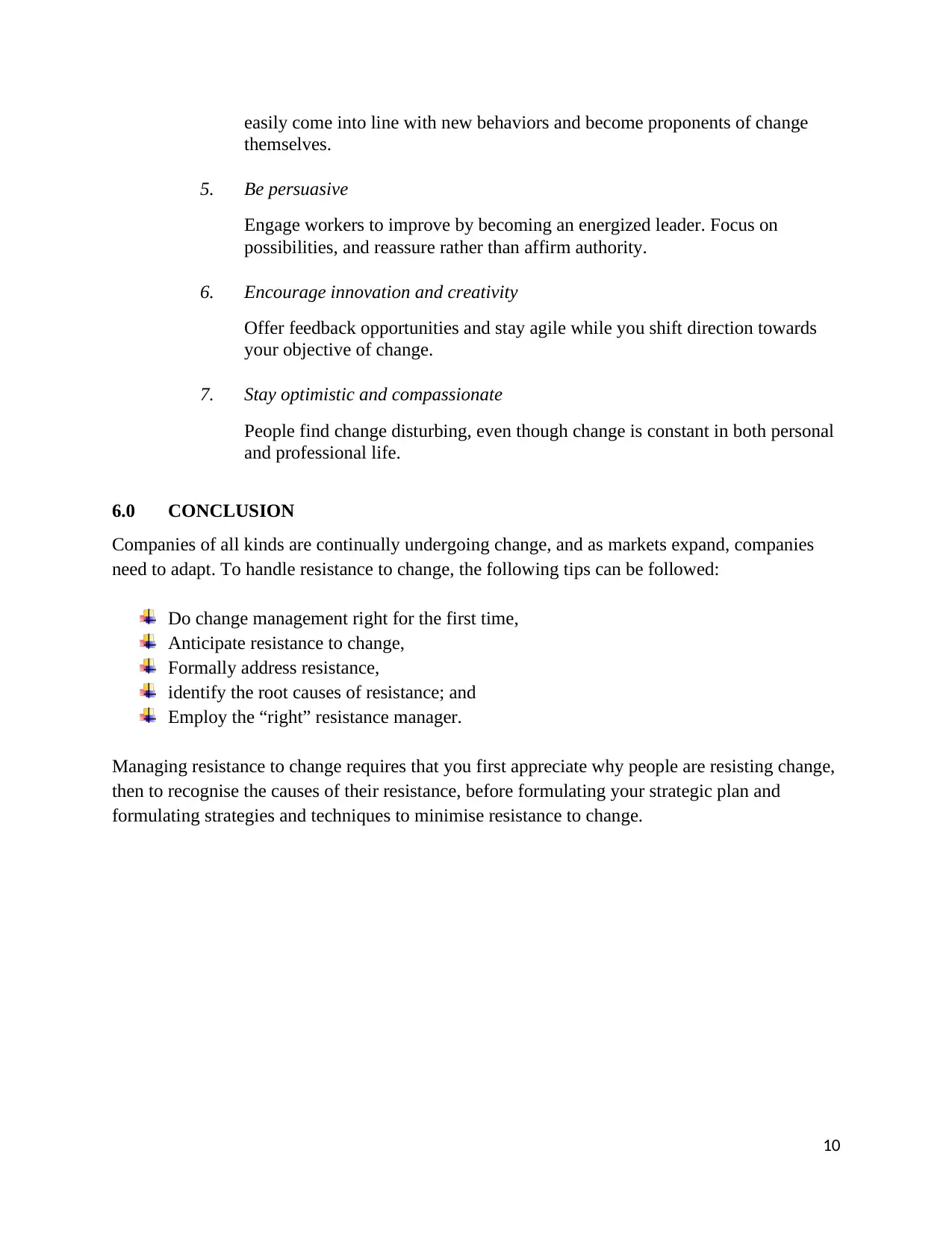
10
easily come into line with new behaviors and become proponents of change
themselves.
5. Be persuasive
Engage workers to improve by becoming an energized leader. Focus on
possibilities, and reassure rather than affirm authority.
6. Encourage innovation and creativity
Offer feedback opportunities and stay agile while you shift direction towards
your objective of change.
7. Stay optimistic and compassionate
People find change disturbing, even though change is constant in both personal
and professional life.
6.0 CONCLUSION
Companies of all kinds are continually undergoing change, and as markets expand, companies
need to adapt. To handle resistance to change, the following tips can be followed:
Do change management right for the first time,
Anticipate resistance to change,
Formally address resistance,
identify the root causes of resistance; and
Employ the “right” resistance manager.
Managing resistance to change requires that you first appreciate why people are resisting change,
then to recognise the causes of their resistance, before formulating your strategic plan and
formulating strategies and techniques to minimise resistance to change.
easily come into line with new behaviors and become proponents of change
themselves.
5. Be persuasive
Engage workers to improve by becoming an energized leader. Focus on
possibilities, and reassure rather than affirm authority.
6. Encourage innovation and creativity
Offer feedback opportunities and stay agile while you shift direction towards
your objective of change.
7. Stay optimistic and compassionate
People find change disturbing, even though change is constant in both personal
and professional life.
6.0 CONCLUSION
Companies of all kinds are continually undergoing change, and as markets expand, companies
need to adapt. To handle resistance to change, the following tips can be followed:
Do change management right for the first time,
Anticipate resistance to change,
Formally address resistance,
identify the root causes of resistance; and
Employ the “right” resistance manager.
Managing resistance to change requires that you first appreciate why people are resisting change,
then to recognise the causes of their resistance, before formulating your strategic plan and
formulating strategies and techniques to minimise resistance to change.
Secure Best Marks with AI Grader
Need help grading? Try our AI Grader for instant feedback on your assignments.
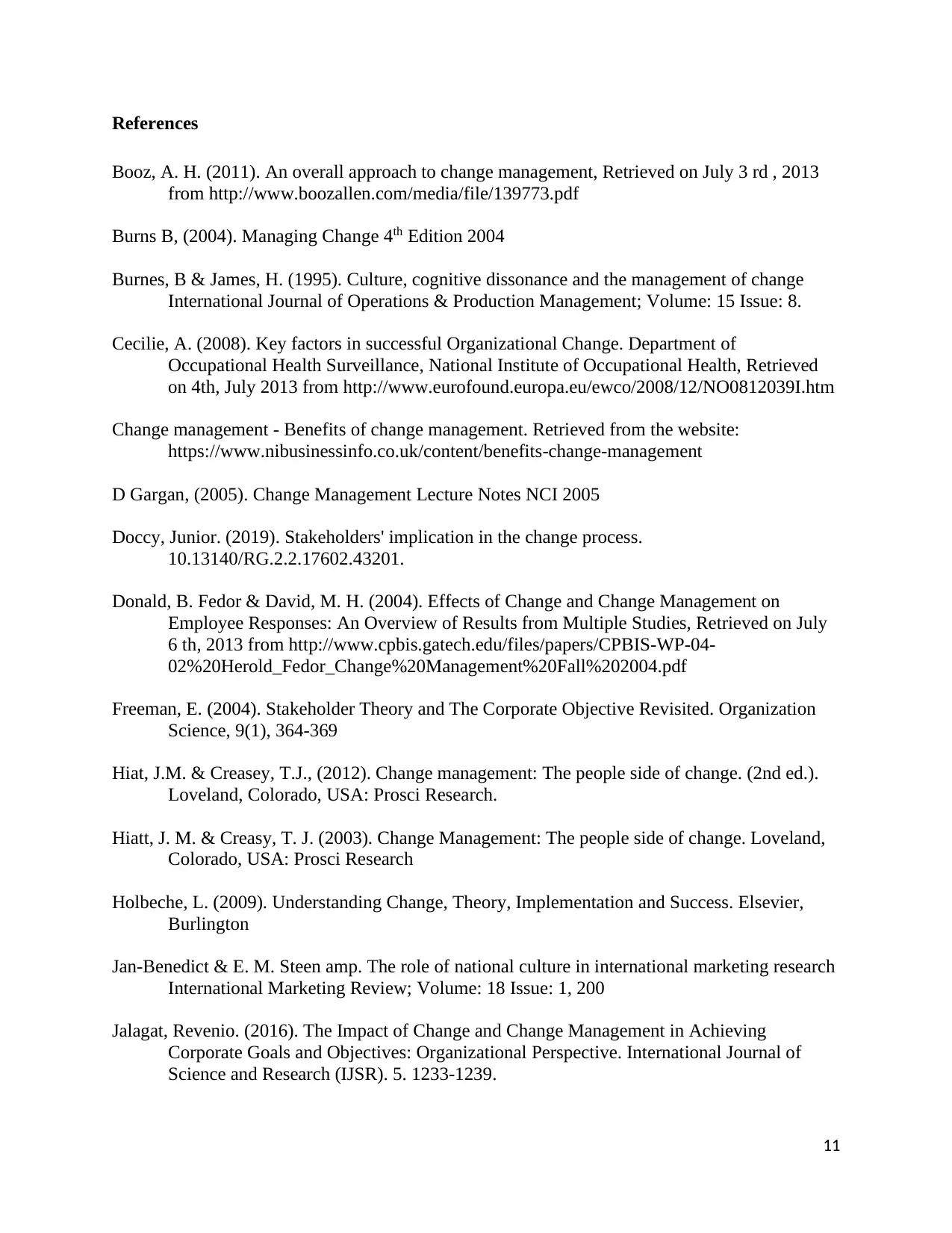
11
References
Booz, A. H. (2011). An overall approach to change management, Retrieved on July 3 rd , 2013
from http://www.boozallen.com/media/file/139773.pdf
Burns B, (2004). Managing Change 4th Edition 2004
Burnes, B & James, H. (1995). Culture, cognitive dissonance and the management of change
International Journal of Operations & Production Management; Volume: 15 Issue: 8.
Cecilie, A. (2008). Key factors in successful Organizational Change. Department of
Occupational Health Surveillance, National Institute of Occupational Health, Retrieved
on 4th, July 2013 from http://www.eurofound.europa.eu/ewco/2008/12/NO0812039I.htm
Change management - Benefits of change management. Retrieved from the website:
https://www.nibusinessinfo.co.uk/content/benefits-change-management
D Gargan, (2005). Change Management Lecture Notes NCI 2005
Doccy, Junior. (2019). Stakeholders' implication in the change process.
10.13140/RG.2.2.17602.43201.
Donald, B. Fedor & David, M. H. (2004). Effects of Change and Change Management on
Employee Responses: An Overview of Results from Multiple Studies, Retrieved on July
6 th, 2013 from http://www.cpbis.gatech.edu/files/papers/CPBIS-WP-04-
02%20Herold_Fedor_Change%20Management%20Fall%202004.pdf
Freeman, E. (2004). Stakeholder Theory and The Corporate Objective Revisited. Organization
Science, 9(1), 364-369
Hiat, J.M. & Creasey, T.J., (2012). Change management: The people side of change. (2nd ed.).
Loveland, Colorado, USA: Prosci Research.
Hiatt, J. M. & Creasy, T. J. (2003). Change Management: The people side of change. Loveland,
Colorado, USA: Prosci Research
Holbeche, L. (2009). Understanding Change, Theory, Implementation and Success. Elsevier,
Burlington
Jan-Benedict & E. M. Steen amp. The role of national culture in international marketing research
International Marketing Review; Volume: 18 Issue: 1, 200
Jalagat, Revenio. (2016). The Impact of Change and Change Management in Achieving
Corporate Goals and Objectives: Organizational Perspective. International Journal of
Science and Research (IJSR). 5. 1233-1239.
References
Booz, A. H. (2011). An overall approach to change management, Retrieved on July 3 rd , 2013
from http://www.boozallen.com/media/file/139773.pdf
Burns B, (2004). Managing Change 4th Edition 2004
Burnes, B & James, H. (1995). Culture, cognitive dissonance and the management of change
International Journal of Operations & Production Management; Volume: 15 Issue: 8.
Cecilie, A. (2008). Key factors in successful Organizational Change. Department of
Occupational Health Surveillance, National Institute of Occupational Health, Retrieved
on 4th, July 2013 from http://www.eurofound.europa.eu/ewco/2008/12/NO0812039I.htm
Change management - Benefits of change management. Retrieved from the website:
https://www.nibusinessinfo.co.uk/content/benefits-change-management
D Gargan, (2005). Change Management Lecture Notes NCI 2005
Doccy, Junior. (2019). Stakeholders' implication in the change process.
10.13140/RG.2.2.17602.43201.
Donald, B. Fedor & David, M. H. (2004). Effects of Change and Change Management on
Employee Responses: An Overview of Results from Multiple Studies, Retrieved on July
6 th, 2013 from http://www.cpbis.gatech.edu/files/papers/CPBIS-WP-04-
02%20Herold_Fedor_Change%20Management%20Fall%202004.pdf
Freeman, E. (2004). Stakeholder Theory and The Corporate Objective Revisited. Organization
Science, 9(1), 364-369
Hiat, J.M. & Creasey, T.J., (2012). Change management: The people side of change. (2nd ed.).
Loveland, Colorado, USA: Prosci Research.
Hiatt, J. M. & Creasy, T. J. (2003). Change Management: The people side of change. Loveland,
Colorado, USA: Prosci Research
Holbeche, L. (2009). Understanding Change, Theory, Implementation and Success. Elsevier,
Burlington
Jan-Benedict & E. M. Steen amp. The role of national culture in international marketing research
International Marketing Review; Volume: 18 Issue: 1, 200
Jalagat, Revenio. (2016). The Impact of Change and Change Management in Achieving
Corporate Goals and Objectives: Organizational Perspective. International Journal of
Science and Research (IJSR). 5. 1233-1239.
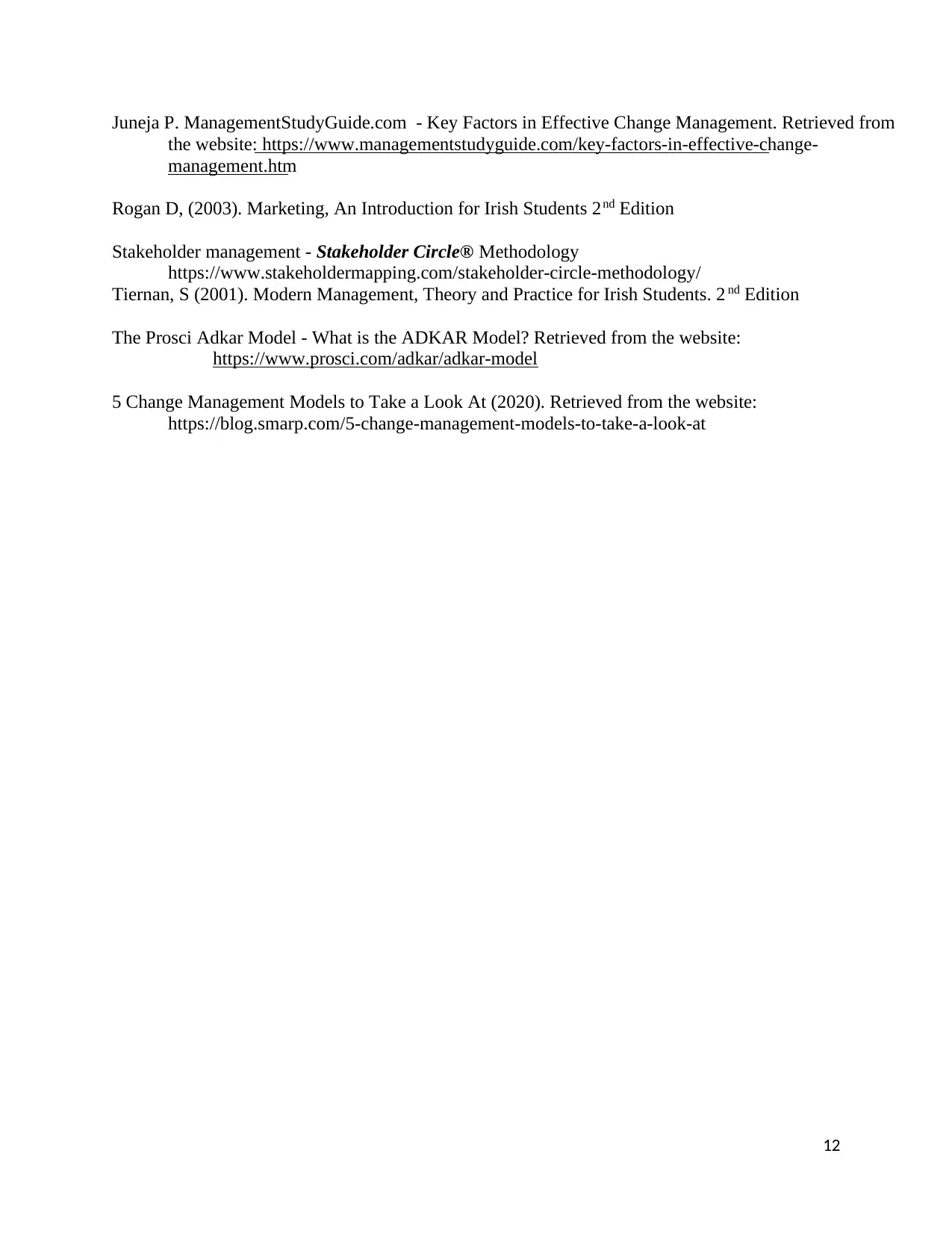
12
Juneja P. ManagementStudyGuide.com - Key Factors in Effective Change Management. Retrieved from
the website: https://www.managementstudyguide.com/key-factors-in-effective-change-
management.htm
Rogan D, (2003). Marketing, An Introduction for Irish Students 2nd Edition
Stakeholder management - Stakeholder Circle® Methodology
https://www.stakeholdermapping.com/stakeholder-circle-methodology/
Tiernan, S (2001). Modern Management, Theory and Practice for Irish Students. 2 nd Edition
The Prosci Adkar Model - What is the ADKAR Model? Retrieved from the website:
https://www.prosci.com/adkar/adkar-model
5 Change Management Models to Take a Look At (2020). Retrieved from the website:
https://blog.smarp.com/5-change-management-models-to-take-a-look-at
Juneja P. ManagementStudyGuide.com - Key Factors in Effective Change Management. Retrieved from
the website: https://www.managementstudyguide.com/key-factors-in-effective-change-
management.htm
Rogan D, (2003). Marketing, An Introduction for Irish Students 2nd Edition
Stakeholder management - Stakeholder Circle® Methodology
https://www.stakeholdermapping.com/stakeholder-circle-methodology/
Tiernan, S (2001). Modern Management, Theory and Practice for Irish Students. 2 nd Edition
The Prosci Adkar Model - What is the ADKAR Model? Retrieved from the website:
https://www.prosci.com/adkar/adkar-model
5 Change Management Models to Take a Look At (2020). Retrieved from the website:
https://blog.smarp.com/5-change-management-models-to-take-a-look-at
1 out of 12
Related Documents
Your All-in-One AI-Powered Toolkit for Academic Success.
+13062052269
info@desklib.com
Available 24*7 on WhatsApp / Email
![[object Object]](/_next/static/media/star-bottom.7253800d.svg)
Unlock your academic potential
© 2024 | Zucol Services PVT LTD | All rights reserved.





